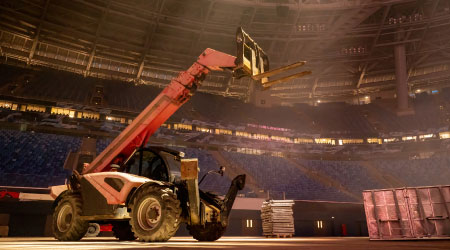 Technology advances make new-generation lifts potentially the safest ever built, but proper use requires that only trained, experienced, certified users operate the equipment to take full advantage of the safety features.
Technology advances make new-generation lifts potentially the safest ever built, but proper use requires that only trained, experienced, certified users operate the equipment to take full advantage of the safety features.Understanding Job Tasks for Better Lift Specification
Managers who understand the needs of a specific job can specify the proper lift for the job.
Making a match
Once managers better understand department needs, equipment features, and staffing considerations, they can determine which type of lift is most appropriate for their situation. Among the top considerations for lifts are: the maximum reach needed; the maximum weight capacity allowed; and the overall dimensions to ensure access to the job, including lowered height, width, and length.
Depending on the required reach, raising material might require forklifts, telehandlers, boom lifts or mast lifts. Outside work might require units with balloon tires, while inside work on hard, smooth surfaces requires solid-tire lifts.
Controls for working on uneven surfaces need to give the operator the ability to measure the angle of repose and warn of unsafe conditions or even stop the equipment if a tipping risk exists. Lift equipment accidents can occur when the load is too heavy for the equipment, the required reach is too short, or the terrain slope conditions are too steep. Manufacturers constantly uncover new trends and incorporate them into designs. More compact units meet the needs of most projects more economically and with improved productivity in tight workspaces. Crews also can tow compact lifts behind a work truck, eliminating trailer transport costs to and from the job site.
In addition to conventional uses, such as moving pallets structural steel, and heavy equipment, managers should consider other uses for lifts that add to worker productivity and greater lift utilization. For example, more departments use a combination of a towable compact telehandler, a work truck, and a mast-controlled work platform or scaffold. Workers can move the mast-controlled scaffold between locations using one telehandler operator and eliminate the need for a crew to disassemble and assemble scaffolding for every move.
Given the ever-expanding workload for maintenance and engineering departments, managers cannot afford to waste either time or money in making a decision on lifts. But ultimately, their top priority must be to find the option that enables workers to complete essential tasks efficiently, cost-effectively and safely.
Thomas Westerkamp is a maintenance and engineering management consultant and president of the work management division of Westerkamp Group LLC, www.westerkampgroup.com.
Related Topics:















